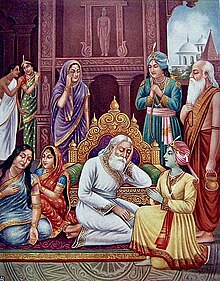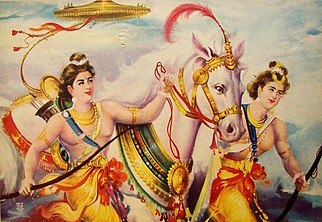List of Ikshvaku dynasty kings in Hinduism

According to Hindu traditions, Shraddhadeva Manu (Sanskrit manuśraddhādeva) is the current Manu and the progenitor of the current manvantara. He is considered as the seventh of the fourteen Manus of the current kalpa (aeon).[1]
Shraddhadeva Manu was the king of the Dravida kingdom[2] before the Pralaya, the great flood. Forewarned about the flood by the Matsya avatar of Vishnu, he saved humanity by building a boat that carried his family and the saptarishi to safety. He is the son of Vivasvana and is therefore also known as Vaivasvata Manu, and his dynasty as the Suryavaṃśa. He is also called Satyavrata (always truthful). Ikshvaku (Sanskrit; ikṣvāku, from Sanskrit ikṣu; Pali: Okkāka), is one of the ten sons of Shraddhadeva Manu, and is credited to be the founder of the Ikshvaku Dynasty.[3]
Suryavamsha kings



The genealogy of the Ikshvaku dynasty to Rama is mentioned in the Ramayana in two lists. The only difference between the two lists is that, Kukshi is mentioned only in the second list. In the first list, Vikukshi is mentioned as the son of Ikshavaku. The descendants of Vikukshi are known as Vikauva.[4]



- Vaivasvata Manu or Satyavrata or Nabhi[5]
- Ikshvaku
- Kukshi[6] or Vikukshi[a] or Śaśāda
- Bāna or Shakuni
- Kakutstha or Puranjaya (Purañjaya) or Anaranya I
- Anena (Anenā)[b]
- Prithu (Pṛthu)
- Vishtarashva (Viṣṭarāśva), Visvarandhi, or Viśvagandhi
- Chandra (Cāndra-yuvanāśva)
- Yuvanashva I (Yuvanāśva)
- Shravasta (Śrāvasta)
- Brihadashva (Bṛhadaśva)
- Dhundumār (Dhundhumāra) or Kuvalayashva (Kuvalayāśva)
- Dhreedhashva (Dṛḍhāśva) or Kapilashva (Kapilāśva) or Bhadrashva (Bhadrāśva)
- Pramoda
- Haryashva I
- Nikumbha
- Baharnashva (Barhaṇāśva)
- Giritashva
- Amitashva (Amitāśva)
- Krishashva (Kṛśāśva) or Akrutashva
- Prasenajit I
- Yuvanashva II
- Mandhata
- Purukutsa I (or Vasuda) and Muchukunda
- Ambarisha
- Trasadasyu
- Sambhruta
- Anaranya II
- Preeshadashva
- Haryashva II
- Hastya
- Sumana
- Tridhanva
- Trayyaruni
- Trishanku or Satyavrata II
- Harishchandra
- Rohitashva
- Harita
- Chanchu
- Chakshu or Sudeva
- Vijaya
- Ruruka or Brahuka
- Pratapendra
- Bruka
- Sushandhi
- Bahuka
- Vrika or Bharata II
- Bahu or Asita
- Sagara
- Amshuman
- Dilipa I
- Bhagiratha
- Suhotra
- Shruti
- Kukutsa II
- Raghu I
- Nabhaga
- Ambarisha II
- Shindhudvipa
- Ayutayu
- Pratayu
- Rituparna
- Sarvakama I
- Sudasa
- Kalmashapada
- Asmaka (Aśmaka)
- Mulaka or Sarvakama II
- Dasharatha I
- Ilibil or Ananaranya III
- Vishvamashaha
- Nidhna
- Animitra (Anamitra)
- Duliduh or Mūlaka
- Dilipa II or Dirghabhahu or Khaṭvāṅga
- Raghu II
- Aja
- Dasharatha II
- Bharata III
- Rama
The other sons of Dasharatha; Lakshmana and Shatrughna were said to be the kings of Karupada and Malla, and Madhupuri and Vidisha respectively.
Suryavamsha kings after Rama


Rama and his brothers were succeeded by their respective sons; Kusha had inherited South Kosala and Lava had inherited North Kosala, while Bharata's children, Taksha and Pushkara, had inherited Takshashila and Pushkalavati respectively. Lakshmana's children, Angada and Chandraketu, had inherited Karupada and Malla respectively, and Shatrughna's children, Subahu and Shatrughati had inherited Madhupuri and Vidisha respectively.
The Puranas provide a genealogical list from Kusha to Brihadbala, who was killed by Abhimanyu in the Kurukshetra War. This list is corroborated by the Raghuvamsha till Agnivarna.[7]
- Kusha and Lava
- Atithi
- Nishadha
- Nala II
- Nabhas
- Paundrika
- Kshemadhanva
- Devanika
- Ahinagu
- Ruru
- Pariyatra
- Sala
- Dala
- Bala
- Uktha
- Sahasrasva
- Para II
- Chandravaloka
- Rudraksh
- Chandragiri
- Banuchandra
- Srutayu
- Uluka
- Unnabha
- Vajranabha
- Sankhana
- Vyusitasva
- Visvasaha
- Hiranyanabha Kausalya
- Para III
- Brahmistha
- Putra
- Pusya
- Arthasidhi
- Dhruvasandhi
- Sudarsana
- Agnivarna
- Sighraga
- Maru
- Parsusruta
- Susandhi
- Amarsana
- Mahasvana
- Sahasvana
- Visrutvana
- Visvabhava
- Visvasahva
- Nagnajit
- Brihadbala
Suryavamsha kings after Mahabharata
The Puranas also provide the list of the kings from Brihadbala to the last ruler Sumitra. But these lists mention Shakya as an individual, and incorporate the names of Shakya, Shuddodhana, Siddhartha (Gautama Buddha), and Rahula between Sanjaya and Prasenajit. The names of the kings are:[8]
- Successors of Brihadbala-
- Brihatkshaya (or Bruhadrunama)
- Urukriya (or Gurukshepa)
- Vatsavyuha
- Prativyoma
- Bhanu
- Divakara (or Divaka)
- Virasahadeva
- Brihadashva II
- Bhanuratha (or Bhanumana)
- Pratitashva
- Supratika
- Marudeva
- Sunakshatra
- Pushkara (or Kinnara)
- Antariksha
- Suvarna (or Sutapa)
- Sumitra (or Amitrajit)
- Brihadraja (Okkaka)
- Rudraksha
- Descendants through the Shakya lineage-

- Kritanjaya (Sivisamjaya)
- Ranajjaya (Sihassara)
- Jayasena (Mahakoshala or Sanjaya)
- Sihahanu (Shakya)
- Śuddhodana
- Siddhartha Shakya (Gautama Buddha)
- Rāhula
- Later Ikshvakus, of the original lineage and rulers of Kosala-
- Sanjaya Mahākosala
- Prasenajit
- Viḍūḍabha
- Kshudraka (or Kuntala)
- Ranaka (or Kulaka)
- Suratha
- Sumitra
According to Bibek Debroy, King Sumitra claimed to be the last ruler of the Suryavamsha dynasty of Kosala, as he was defeated by Mahapadma Nanda of Magadha in 362 BCE. However, he wasn't killed, and fled to Rohtas, located in present-day Bihar, where his son Kurma had established his reign.[9]
See also
- Solar dynasty
- Lunar dynasty
- Vedic science
- History of India
- Puranic chronology
- History of Hinduism
- Puru and Yadu Dynasties
- List of Hindu empires and dynasties
Notes
References
- ^ V. R. Ramachandra Dikshitar (1935). The Matsya Purana: A Study. University of Madras. p. 5.
- ^ Rhonda Burnette-Bletsch, Jon Morgan (ed.). Noah as Antihero: Darren Aronofsky's Cinematic Deluge. Taylor & Francis, 2017. p. 45.
- ^ The Hare Krsnas - The Manus - Manus of the Present Universe
- ^ Vyas, R. T., ed. (1992). Vālmīki Rāmāyaṇa, Text as Constituted in its Critical Edition. Vadodara: Oriental Institute, Vadodara. pp. 91–92, 255–56.
- ^ Doniger, Wendy, ed. (1993), Purana Perennis: Reciprocity and Transformation in Hindu and Jaina Texts, State University of New York Press, ISBN 0-7914-1381-0
- ^ Ramayana, Balakanda,verse 70
- ^ J.P Mittal (2006). Surya Dynasty:Name of Kings. Atlantic Publishers & Distributors. ISBN 81-269-0616-2.
- ^ Misra, V.S. (2007). Ancient Indian Dynasties, Mumbai: Bharatiya Vidya Bhavan, ISBN 81-7276-413-8, pp.283-8, 384
- ^ Debroy, Bibek (25 October 2017). The Valmiki Ramayana, Volume 3. Penguin Random House India Private Limited. ISBN 9789387326286.
- Sources